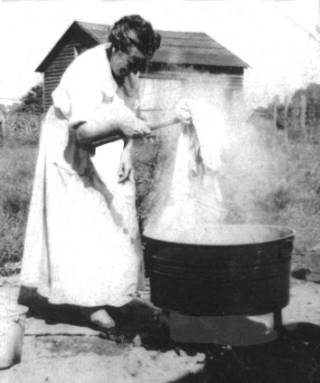

| A |
s I grew up on a farm the month of March turned our lifestyle into a bustle of activity. It came blustering in, bringing with it the first sunny, warm, springlike days we needed to get the year’s work under way. So many chores needed attention it was hard to decide which had top priority on the list.
One thing that was a must to get done in March was the soap making. The weather needed to be warm enough so the soap did not freeze and ruin, but still early enough that the insects did not get into the fat meat scraps that had been saved during the winter to use for the soap.
There were three kinds of homemade soap. One was the kind made with ash hopper lye. It was usually stored in a barrel because it did not harden enough to be cut into bars or chunks. Then there was a cold soap that could be made without cooking. Cold soap required clear strained grease as opposed to meat scraps and was the easiest kind to make. However it was not often we had that much pure grease (lard) to spare for cold soap.
The soap we made most often was the kind we cooked in the wash pot. We dumped the required amount of water, lye and meat scraps into the pot and made a fire just sufficient for low boiling or simmer until the lye ate all of the scraps it would. Then we drew the fire from under the pot to stop the cooking and fished out the parts of meat the lye did not dissolve, such as the bones. This type of soap making required constant stirring during the whole process of cooking and cooling. While cooling the more stirring, whipping and pouring we did the whiter and fluffier the soap was. If we stuck with it religiously, we could have white soap that floated (like Ivory) and if we used a paddle made of sassafras we had soap that smelled good. One thing we tried to avoid with all the stirring was not to get spatters on the bare skin. The soap was called raw soap and until it dried and cured for about three weeks it would burn the skin and make sores just like a heat burn.
With all the soap for cleaning uppermost in our minds our thoughts turned to house cleaning. And in addition to getting rid of the accumulated dust and dirt we had to conquer the bed bugs (or chinches). There were very few rent houses not infested with the pesky things. I don’t know of any pests that multiplied faster or were more immune to all our efforts to get rid of them. Of course we had very little in the way of pesticides to use in those days, just Bee Brand insect dust that smelled awful but killed anything. And coal oil and boiling water that we could not get into all the places where bed bugs lived and laid their eggs.
To slow the bed bugs down and thin them out we took down and outside the beds and all the bedding, emptied the old strawticks and burned the straw. We washed and boiled all the strawticks, quilts, blankets and anything that was used on the beds that was washable. We scalded the bed slats and springs and poured boiling water in all the cracks and crevasses that the water would not ruin. We cleaned all other furniture and used a coal oil-soaked rag to get at places we could not pour water. We cleaned the walls as best we could, sometimes throwing boiling water on them then re-papering. We then scrubbed the floors using the scalding water. We put new straw in the clean ticks and set the bedposts in cans of coal oil and kept the beds and all other furniture away from the walls about two inches. We then could sleep in peace for a few weeks until another batch hatched out then we had the whole bit to do over. All of this seems like such a lot of hard work (and it was) but having bed bugs was somewhat akin to having the itch or plague -- embarrassing to have but impossible not to have, especially for people who moved a lot from house to house. March was not just a time for doing chores, though. The warm days meant I could shed my itchy, scratchy, baggy, uncomfortable long john underwear. How I hated those things! I promised myself that when (if ever) I became my own boss I’d never wear another pair. Another happy moment was when I could take off my shoes and go barefoot on the first warm day. That was not too much change for my feet to adjust to, because by March my shoes were so badly worn they were just make-believe to fool my feet. How I did love the feel of the new grass so cool on my bare feet and if I could find some mud to squish between my toes or wade a branch that was really the life for me. However it only took about two days for me to get many stubbed toes, cuts, skins and bruises that made my feet so sore I could not wear shoes until cool weather again. By that time my feet were so toughened I could wear winter shoes when school started in the fall. I still love the warm spring days that March brings each year.